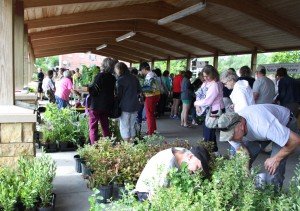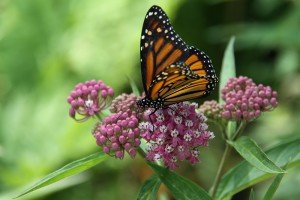By MARIA HERD
Looking to add flowers and greenery to your property? Hoping to attract butterflies and birds to your garden, or make a difference in helping Minnesota wildlife? Do you want to learn more about plants that are native to the state? If you answer yes to any of the questions, look no further than the Native Plant and Expo Market on Sat., June 4 at the Cub Foods Community Pavilion, 1201 Larpenteur Ave W., Roseville.
“This is the go-to event in the Twin Cities if you’re interested in native plants,” said Nancy Schumacher, who owns The Vagary, a native plant growing business. Schumacher has been growing native plants with her husband for over 30 years and has participated in the annual Native Plant and Expo Market many times.
 Attendance has increased over the years. In 2011, there were 400 attendees. Last year 1,800 people purchased plants at the market.
Attendance has increased over the years. In 2011, there were 400 attendees. Last year 1,800 people purchased plants at the market.
Photo right: The 2015 Native Plant and Expo Market saw great crowds. Last year 1800 people purchased plants at the market. Get there early to get the very best selection of plants for your yard! (Photo by Karen Eckman)
“This is a robust event because it’s hard to find native plants in the metro area,” said Leslie Pilgrim, event organizer and a volunteer at the non-profit Wild Ones that promotes Native Plant education in the Twin Cities.
According to Schumacher, Twin Cities residents have to drive about 30-40 miles out of town to purchase native plants. Her business is located 30 miles south in Randolph. Many growers like Schumacher do not have a retail store and instead come to into the Cities for farmers markets and events like the Expo Market.
“The idea is: let’s bring all these growers together in the cities for a one-day event,” she said.
A total of 12 growers are participating this year, and will be selling everything from potted flowers to shrubs and trees.
Why native plants?
“Native plants are multifunctional,” explained Pilgrim. “They have deep roots, conserve soil, filtrate water, provide pollen and nectar, and serve as a resource for birds.”
Many factors nowadays threaten pollinators’ habitats like climate change, land development, pesticides and non-native plants.
Choosing plants that are native to Minnesota and pesticide-free provides “clean food” for wildlife, said Pilgrim.
In addition, non-native plants “are not going to supply the same quality and quantity of nectar [as natives],” said Schumacher.
Many pollinators–like bees, butterflies, and birds–are dependent on specific plants for their survival.
“Insects are picky eaters,” Pilgrim explained. “Sometimes they don’t recognize these other plants as a food source or even a plant,” she said. This is because native plants have co-evolved with native insects and birds for thousands of years.
 For example, monarch butterflies are dependent on milkweed for food and to lay eggs; they cannot survive on other plants.
For example, monarch butterflies are dependent on milkweed for food and to lay eggs; they cannot survive on other plants.
Photo left: A monarch butterfly on a rose milkweed. There are any number of milkweed varieties that can be grown in Minnesota. (Photo by Karen Eckman)
Their populations have declined by 90 percent in the last 20 years, says the National Wildlife Federation, which has prompted many communities to take action.
In March, Mayor Chris Coleman and Minneapolis Mayor Betsy Hodges signed the Mayors’ Monarch Pledge to restore habitats in the community and encourage citizens to join the cause. The Twin Cities are the 100th locale nationwide to take the pledge.
Monarchs will migrate from Mexico to the upper Midwest this summer, just in time for the Native Plant and Expo Market. Four types of Milkweed, which Monarchs naturally thrive on, will be available to purchase at the event.
Furthermore, native plants are more sustainable and ready to deal with Minnesota’s harsh winters.
“They are the toughest plants you can get it because they’re from here, so they have evolved to deal with our winters, climate factors, and soil conditions,” said Schumacher.
These plants are like an investment, said Pilgrim, because you know that they will come back next year.
When enough people invest in native plants in a neighborhood, these small patches connect and are called habitat corridors, according to an event press release. These corridors allow animals to move across the landscape and offset wildlife losses due to land development.
“If you don’t have host plants, you don’t have insects, and you don’t have wildlife,” said Pilgrim.
Educating the community
The Native Plant and Expo Market is more than just a sale; it’s an educational event for the community.
There will be a total of 12 exhibition educational participants at this year’s market to educate the public on environmental issues and assist customers in choosing plants that would be right for their property and Minnesota wildlife.
“They are all there strictly as volunteers wanting to get the word out about native plants and pollinators,” said Schumacher.
This year’s participants include Restoring the Landscape, Sue Prints Plants, St. Paul Audubon Society, University of Minnesota Bee Lab and Bee Squad, Monarch Joint Venture, Wild Ones, Blue Thumb, Capital Region Watershed, Ramsey Conversation District, Minnesota Wildflowers Information, Ramsey County Cooperative Weed Management Area and the Minnesota Native Plant Society.
These volunteers have a wide variety of expertise and are willing to share their advice for free, said Pilgrim.
According to Schumacher, this is a fairly competitive industry so plant prices at the market are about the same as they would be at a garden center.
She sells her smallest plants for a $1 a pop in a six pack, $3 for plants that are a little larger around 3.5 inches, and $8-10 for gallon potted plants. Outback nursery shrubs and trees sold by other growers are naturally more expensive. According to one of the grower participant’s online catalog, smaller trees cost as low as $21.45, and big trees can cost up to $160.
While some large-scale environmental issues make people feel powerless as individuals, investing in native plants to restore wildlife is a “practical solution” according to Pilgrim.
“Even if you have a small space, a pot on the back patio or an apartment balcony, you can still make a difference. What you plant matters,” she said.
Comments
No comments on this item Please log in to comment by clicking here